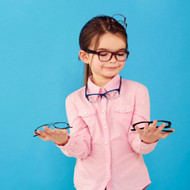Best Practices for Fitting Kids Glasses: Ensuring Comfort and Eye Health
12th Nov 2023

Having your child's glasses fitted properly is vital for many reasons. Firstly, and most importantly, ill-fitting glasses can negatively impact a child's vision. Glasses that are too loose or too tight can cause visual distortion and discomfort, making it difficult for children to see clearly. But glasses that fit well help children to see clearly and comfortably, and this is essential for daily activities such as reading, learning, and playing.
Poorly fitted glasses can also have other adverse effects. For instance, too tight and glasses can put pressure on the nose and behind the ears, leading to headaches. On the other hand, if glasses are too loose, they constantly slip down a child's face, requiring continual adjustment, which can be distracting, frustrating and a deterrent to wearing them.
As discussed in another blog post, Top Places to Buy Kids' Glasses in Australia, ensuring you choose a retailer experienced in fitting children's glasses should be a key factor in deciding where to buy your child's glasses. So let’s look at some of the best practices for making sure your child's glasses are fitted correctly so they are comfortable to wear and promote good eye health.

Choosing the right frames
Selecting the appropriate frames for your child is the first and crucial step in ensuring a proper fit. Frames should be lightweight and durable to withstand daily wear and tear, but most importantly, they must fit your child's face correctly.
There are three key measurements to consider when having your child fitted for glasses: lens width, bridge width, and temple length.
Frame Size
As cute as it can be seeing a little kid wearing oversized glasses like a grown up, this is not going to be practical or help your child see well. Glasses that are too big will be heavy and uncomfortable, especially if their prescription is high.
Aim for the glasses to be around the same size as their eye socket. Their pupil should be centred horizontally and vertically in the lenses. The width of the glasses shouldn’t protrude out the side of their heads, but rather be in line.
A lot of parents will end up with frames that are too big for their child simply because the eyecare professional will advise them that the child will ‘grow into them’. Glasses are a medical device and should fit NOW, not in two years’ time.
Overall, it's important to choose frames that are just right and not too wide or too narrow for your child's face, as this can affect the fit and comfort of the glasses.

As cute as these frames are, they are too big and a poor fit for this child's face. See how her eyes and pupils are not centred in the lenses. And the bridge of the glasses is sitting almost at her eyebrows rather than the bridge of her nose.
Bridge Width
Another part of the frame that’s important is the bridge width. The bridge width is the distance between the two lenses – so the bit that’s going to sit across the nose. It should be wide enough to fit comfortably on your child's nose without causing discomfort or leaving marks. The bridge shouldn’t sit will above the bridge of the nose as this will also cause discomfort.
Sometimes children will have quite a low or flat bridge (this can especially be the case for Asian faces and children with Down Syndrome). It’s really important then to find a frame that is suitable for a low bridge. Tomato Glasses are a fantastic option in this case as the bridge can be adjusted.
The nose pads should be adjusted to fit the contours of your child's nose, which will minimise any discomfort and pressure. This is obviously the case for frames that have separate nose pads.
Temple Length
The temple length refers to the length of the arms that extend from the frames to the ears. Choose frames with temple arms that are neither too long nor too short, as an incorrect length can impact the fit and stability of the glasses.
Temples can usually be adjusted to bend around the ears as needed. And some frames, like Tomato Glasses, can have the actual temple length cut to make the perfect fit.
Ensure they fit snuggly behind the ear without being too tight. The fit should be specific to your child's facial features, resulting in the glasses sitting securely and comfortably on their ears without causing any irritation or soreness.
Finally, check for pressure points
Fitting new glasses isn't always a quick process, as it can take time to make fiddly incremental adjustments to avoid pressure points.
Glasses should fit snugly without causing any discomfort or leaving marks, especially behind the ears, which is commonly where ill-fitting glasses cause excessive pressure or soreness.
During the fitting process, keep checking in with your child to identify any sore points or pressure so that adjustments can be made to relieve them. Glasses that hurt your child won't be worn, so it's vital to get the fit right for your child from the start.

Conclusion
Proper fitting of kids' glasses is crucial for comfort, eye health and how well they see. An experienced fitter of children's glasses will take precise measurements, adjust the nose pads and temple arms, and check for comfort and alignment so your child can enjoy a secure fit for their glasses. And remember, if they tell you your child will ‘grow into them’ – run!
If your child is new to wearing glasses, it might take some time to get used to them, so don't be shy of returning for adjustments if needed. Remember, well-fitted glasses allow your child to see clearly and comfortably and thrive in their daily activities.

